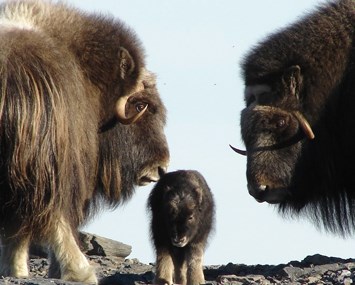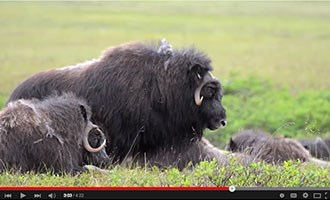
NPS Photo / Roy Wood 
NPS Photo / Jason Gablaski Species Name: Ovibos moschatus Dating back to about 187,000 to 129,000 years ago, muskoxen are known as the shaggy survivors of the Ice Age. Today, muskoxen are found in northern Canada, Greenland, and Alaska. Inupiaq speakers call them umiŋmak, meaning "the animal with skin like a beard" for their distinct fur that hangs down nearly to the ground. FoodThese hardy beasts eat mostly plants for breakfast, lunch, and dinner. During the spring, the greening of the tundra lays out a feast of willow leaves, tussocks, grass shoots, and flowers. You may often find them in the undulating tundra with their muzzles buried in the vegetation, eating up the greenery in preparation for winter. During winter, when the entire tundra is covered in snow, muskoxen use their excellent sense of smell to find food. They use their front hooves to dig through the snow or they drop their head to break through a crust of snow. Their scarce winter diet includes dried grasses, sedges, willows, and lichen. FamilyMuskoxen live in complex social circles. You may often see a herd of up to 75 muskoxen frolicking through the tundra, loafing in meadows, or splashing around in puddles. Late summer into autumn is breeding season for these hairy beasts, but before romance can ensue, dominance must be fought for. Bulls will often push each other, lock their horns, or bellow like lions. Sometimes the fight for dominance turns the tundra into a battlefield. Head-on collisions and multiple charges make for a spectacular scene. How can these muskoxen survive such blows to the head? They have a protective helmet-like horn that is 4 inches thick, plus another 3 inches of skull. Once dominance is established, bulls will gather a breeding harem of about 20 females, which they defend against other bulls that may try to sneak in looking for love. But it's not game-over for the bull; he must patiently wait until a cow consents to breed. A cow gives birth to a single calf in April or May, weighing about 20 to 30 pounds. The calf is able to stand and move around hours after birth. During this time, plants are the most abundant and nutritious and provides small tender shoots for the calf. DefenseWhen danger approaches, muskoxen stick together. Their clever defense strategy has protected them from wolves and other predators. If there is only a single predator, muskoxen form a line of defense in the direction of that predator. If there are multiple predators, the muskoxen form a circle with their heads and horns all facing outward, making the circle impenetrable. Calves will stay near their mother or be at the center of the circle. Depending on the situation, a muskox will occasionally charge the enemy, then quickly rejoin the others. For muskoxen, power in numbers is their defense mantra. AdaptationsWhile other arctic animals spend their winters in hibernation, muskox are the resilient survivors of the arctic. They live in the open, unsheltered tundra, enduring the unforgiving elements that come their way; blizzards, darkness, and freezing temperatures. One secret to muskox survival is their fur, which consists of two layers: a very long outer layer of fur that resembles hair, and a short, fuzzy underlayer of qiviut. Qiviut is truly an amazing fiber. It's one of the warmest fibers in the world, is stronger and more durable than sheep's wool, and is softer than cashmere. During the spring, muskox shed their qiviut as the season warms up. The qivuit often gets stuck on willow branches or grasses and is collected by crafters to make sweaters, scarves, and mittens. History of Muskox in the Seward PeninsulaBy 1900, muskoxen became locally extinct or extirpated in Alaska. The depletion of these animals was due to a combination of factors, which included unfavorable climatic conditions that affected access to food as well as mortalities from predators and hunters. People were effective hunters of muskoxen. During arctic explorations, whalers commercially hunted this species on a large scale. The disappearance of muskoxen became a concern to the US government, and in the 1930s, efforts were made to reestablish the population. In 1930, 36 muskoxen, mostly yearlings and calves, were captured in Greenland and transported to the Biological Survey Experiment Station in Fairbanks for five years. Later, four muskoxen were taken to Nunivak Island, 25 miles off the coast of western Alaska. In 1936, the 27 muskoxen that remained in Fairbanks were transported down the Yukon via barge to the community of St. Michael in Norton Sound, then later to Nunivak Island. This final leg of their trip was almost a disaster, as the barge began to take in water. Fortunately for these world travelers, they landed safely and lived to repopulate all of Alaska. 
"Bearded Ones" - Muskox on the Seaward Peninsula |
Last updated: December 18, 2025
